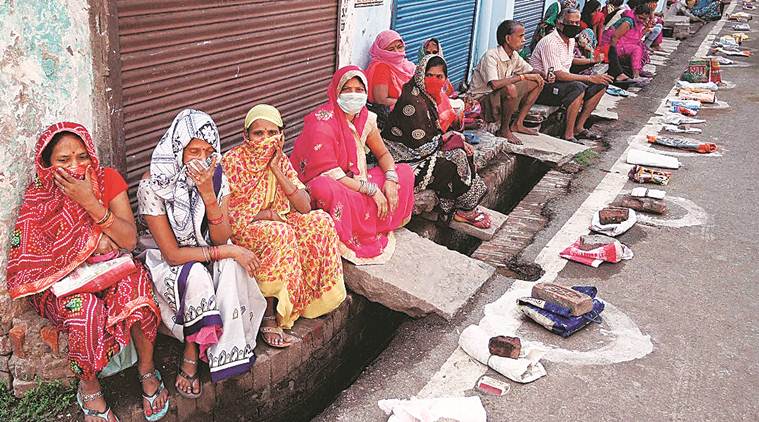 The travails of women have increased manifold. Both within their homes and outside, women struggle with gender violence, health issues and face economic exclusion. (PTI file)
The travails of women have increased manifold. Both within their homes and outside, women struggle with gender violence, health issues and face economic exclusion. (PTI file)
Society, grappling with the COVID-19 virus, the associated health crisis, and issues of economic revival, has missed out on the signals that reflect the impact of the pandemic on women. Today, the discourse has moved towards facilitating economic recovery and regrettably, there is no evidence that it includes women and their concerns. The state of anonymity and curtailed contact with the outside seems to have increased the apathy in society, and perhaps encouraged the indifference and marginalisation of women from the collective consciousness.
The travails of women have increased manifold. Both within their homes and outside, women struggle with gender violence, health issues and face economic exclusion. This troika is likely to become more noticeable, taking women a few steps back from the critical and minimum level of social and economic development they had witnessed in the last few years.
The present pandemic, with back-breaking work, has left them with almost no time to dream, and little hope of getting back soon to their jobs, hampering their ability to strive, confined as they are within oppressive homes. Regrettably, little public conversation has revolved around these concerns and the few discussions have been unable to project any viable alternatives.
Much of the conversation has been around gender violence reported from within the confines of respectable domesticity, perceived as a haven of safety. A society already ashamed of its sexual predators in public places is now witnessing a situation where homes are also an unsafe place for women. Even during the lockdown, there is concern around abduction, wrongful confinement, molestation and harassment, and that many cases do not surface, more so in the existing circumstances. A community-based cross-sectional study among women in parts of Tamil Nadu (Indian Journal of Community Medicine, 2019) is indicative of three major factors that encourage domestic violence — alcohol consumption by husband, the controlling behaviour of family members, and frustration as a consequence of limited resources.
The lockdown has curtailed employment opportunities and confined male members to their homes, a combination that is frustrating for men and potentially dangerous for women.
There are insufficient reports of community support or social interventions even while women are bereft of dignity and safety. In this time, the “sakhi” in rural communities, who helped a woman handle this abuse, and encouraged her to obtain community and official support, is involved in other tasks. Non-government organisations are also under lockdown.
Other practices reinforce unequal gender equations at home. With the pandemic, there is a reduction in earnings, and family members are constantly at home, with children being educated online. This has increased the number of hours of unpaid work and enhanced the burden on women.
Equally evident are concerns around the health of women, especially of those who rely on community services and the official health machinery. It was inevitable that the available health resources, already inadequate and stretched, are deployed for the pandemic. Women have unique and multiple health needs, and over the years, grass roots health workers such as anganwadi and ASHA workers have provided reproductive and maternal services. These functionaries are presently overwhelmed. Consequently, women have little access to family planning services, to institutional support for deliveries, natal and neonatal support or adequate and regular access to hygiene and sanitary items. Increase in unwanted pregnancies, maternal mortality and neonatal mortality are expected to emerge as major concern areas.
The pandemic has aggravated the trend of declining female participation in the labour force. This period has witnessed a disproportionate economic exclusion of women, both in rural and urban economies. With reverse migration, demand for work has increased in rural areas. The shift of employment from women to men is inevitable in a society that places a premium on men. Moreover, for women in the lower-income strata in rural areas, opportunities in non-farm employment are few, and those in traditional sectors like agriculture and handicrafts have dwindled. In sectors like construction, jobs have become increasingly masculinised. In urban conglomerations, women are largely engaged as informal workers and have little reserves. Today, a majority of the jobs in cities are unavailable or inaccessible.
With unpaid work increasing, and livelihood opportunities decreasing, many women are likely to find it difficult to sustain or rebuild their livelihoods, considering that there is no clear visibility of work being restored soon. The current economic discourse contains little that identifies viable measures to retain the share of women in such sectors. A few sporadic solutions like ensuring payment to women for household work are echoes of earlier conversations, not easily or readily implementable.
A society impacted emotionally and physically by the deadly virus and struggling to come to terms with it, a society in a state of inertia and ennui, is hardly inclined to address specific concerns of one of its sections, however large or important. Past experience has demonstrated that it is futile to expect our collective consciousness to arrive at any consensus to address the needs of this constituency or formulate a viable strategy. Women would need to find their own resources and mechanisms.
This is not the first time they have been left to fend for themselves and it is not the last time that they would be forced to identify their mode of survival whether in “ghare” or “baire” — within or outside her home.
This article first appeared in the print edition on July 25 under the title “New crisis, old exclusion.” The writer is a retired civil servant.
Opinion | Because she counts